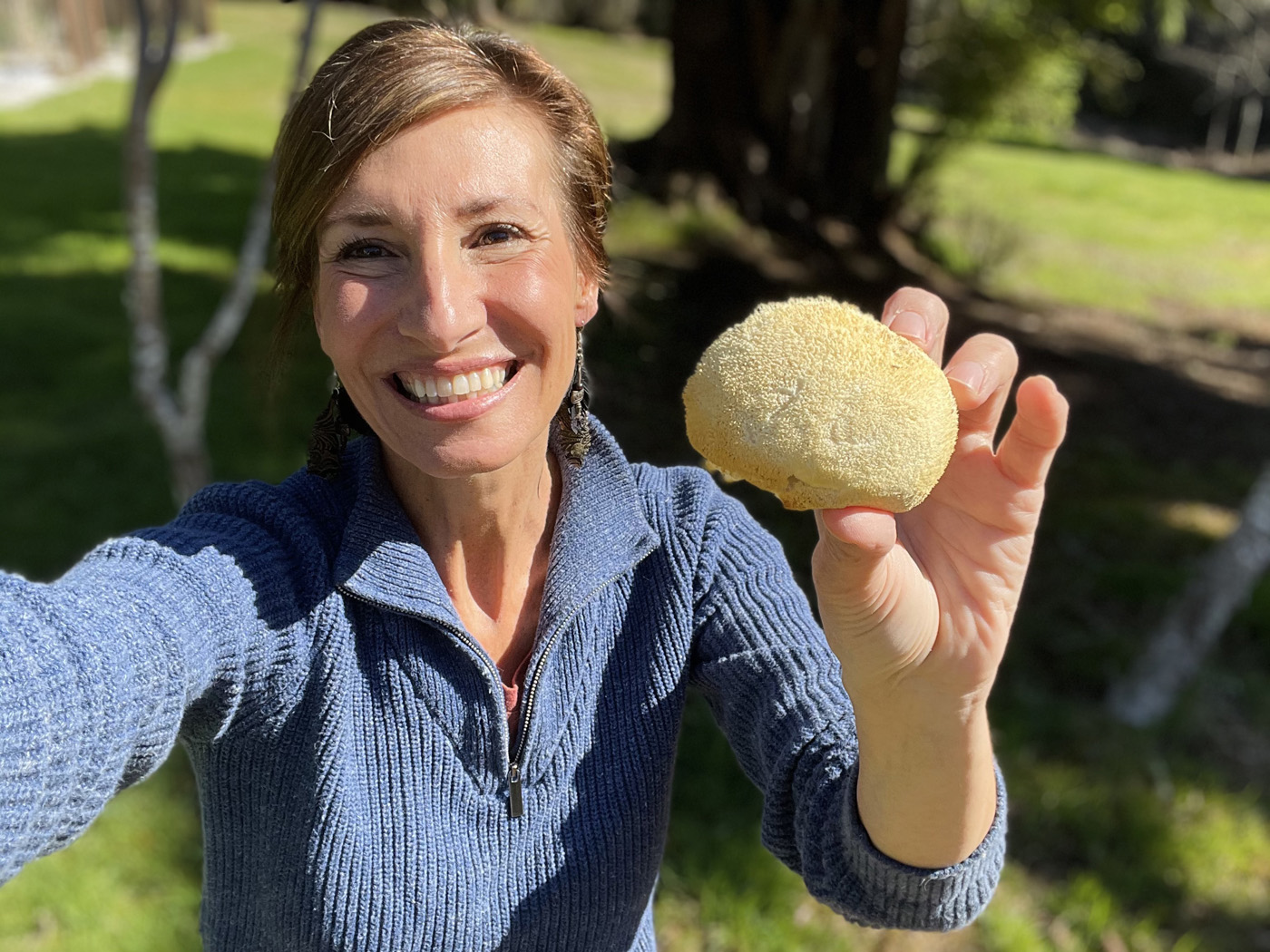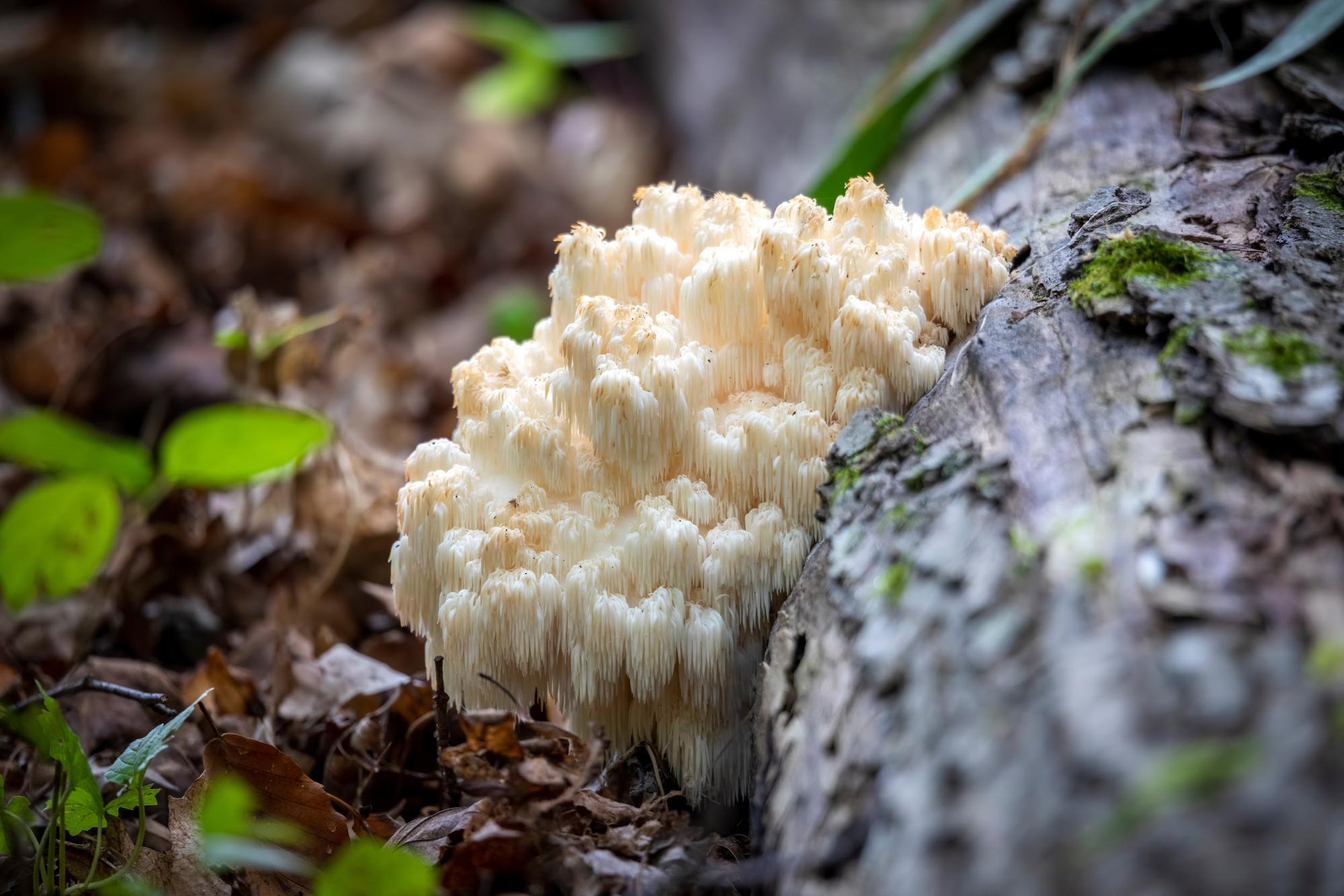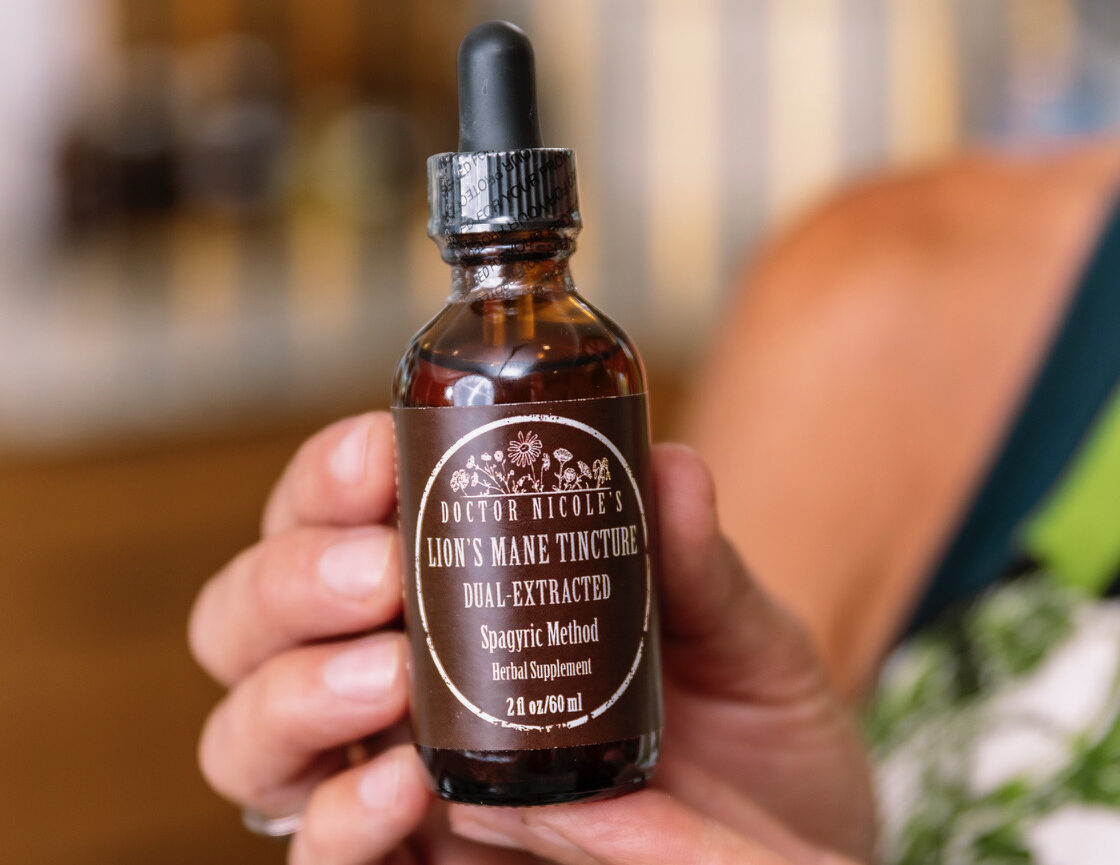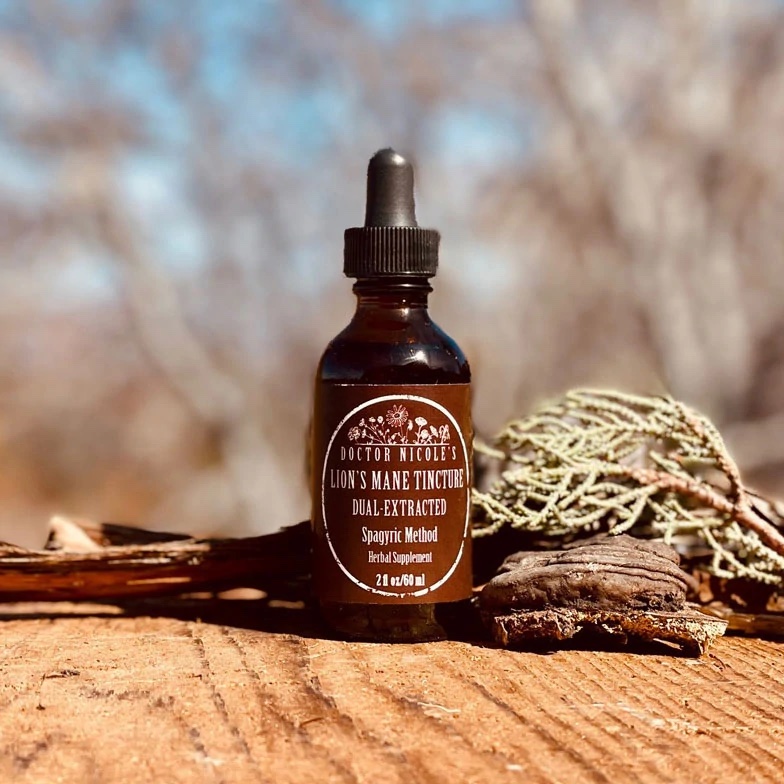A Traditional Medicinal Mushroom for Today
A unique, shaggy mushroom that has been used for thousands of years in Chinese and Japanese traditional medicine, lion’s mane is rich in bioactive compounds that enhance health on a variety of levels. Often referred to as old man’s beard, hedgehog mushroom, bearded tooth fungus, and bear’s head, this is one mushroom that should be on your radar. It grows wild in Asia, Europe, and North America on beech, maple, and oak trees and has a distinctive cascade of downward-growing white tendrils. If you would like to boost immunity, cognitive function, gut health, and mood, while also reducing stress, inflammation, and anxiety — read on. Lion’s mane is truly a health-promoting powerhouse!
Lion’s Mane: A Superior Plant-Based Remedy
Immunity
Shown to improve immune function in animal models, polysaccharides found in the mushroom not only increase T cells and macrophage levels, but also regulate the activity of cells in the intestinal wall.1,2 For those with an autoimmune disorder, this is particularly important. Additional research found that a protein found in the mushroom promotes the growth of beneficial gut bacteria, which further enhances immunity.3
Cancer
Researchers believe antioxidants found in lion’s mane can play a role in cancer prevention and treatment, as seen with the results of an in vitro study against human leukemia.4 The mushroom also showed promise against liver, colon, and gastric cancers in animal models.5 Likewise, a study published in the Journal of Ethnopharmacology found that lion’s mane had anticancer properties against colon and breast cancers, among several others.6 Further animal studies established that extracts of the mushroom inhibited colon cancer metastasis to the lungs by 66 to 69 percent.7
Inflammation
One study in Japan established that the mushroom reduced fatty tissue inflammation, thereby reducing the risk of cardiovascular disease, stroke, and diabetes.16 It was also shown to improve symptoms of acute gut inflammation and bleeding associated with ulcerative colitis in animals according to research published in the International Journal of Medicinal Mushrooms.19

Nerve Regeneration & Neuropathy
Famously known for its ability to regenerate nerves by promoting the production of nerve growth factor (NGF), lion’s mane extract is an outstanding treatment for autoimmune diseases such as multiple sclerosis as well as reducing the pain of neuropathy.20,22-25
Digestive System & The Gut
Several studies have shown lion’s mane has gastroprotective properties not only by reducing the inflammation of gastritis and inflammatory bowel disease, but also due to its antibacterial action against H. pylori, which contributes to ulcers of the stomach and intestines.26,27
Aging
In human cell cultures, lion’s mane extract was shown to reduce aging markers.12 Antioxidants in the mushroom also help fight against skin aging and osteoporosis.13,14 It increased collagen levels in the skin as well.15
Mood & Cognitive Health
Lion’s mane mushroom is well-known for its ability to improve dementia, Alzheimer’s disease, and Parkinson’s, while also addressing depression, anxiety, and sleep disorders.8,9,11,18,22,23 It also improves overall memory and object recognition.10 What’s more, a month-long study involving menopausal women found that the symptoms of poor focus, irritability, palpitations, poor sleep, and anxiety were significantly reduced when they were given lion’s mane extract.17
Not All Lion’s Mane Tinctures Are The Same
If you are seeking the most powerful lion’s mane extract to reap all the health benefits, it is important to know what to look for in an herbal remedy. As I wrote in “Are you using counterfeit mushroom extracts? Here’s how to know the difference.“:
Many are unaware of the difference between products that use mycelium compared to those who utilize the higher quality fruiting body. It can be confusing for consumers to distinguish between the two. Here’s why fruiting body mushroom extracts are superior.
Mycelium are the roots of the mushroom. A good analogy is that mycelium is to mushrooms what roots are to trees. Commercially, mycelium is usually grown on grain, mainly rice or oats. If grown to full size, they will form a complete fruiting body, which is what we normally associate with a mushroom: the stem, cap, and gills. Namely, everything that grows above the bed of grain, bark, or fallen log. The fruiting body contains the majority of nutrients and bioactive compounds like vitamins A, B, C, and D, zinc, and β-Glucans.
The fruiting body also is rich in:
- Triterpenoids—Antioxidant, anti-inflammatory, reduces lipids in the bloodstream, protects the liver, curbs histamine release.
- Ergosterol—Antitumor, antioxidant, a precursor to Vitamin D2.
- Statins—Can lower cholesterol in significant enough doses.
Keep in mind that a fruiting body extract contains 30 to 40 percent beta-glucans, compared to only 5 to 7 percent in mycelium products. Beta-glucans are known to regulate the immune system, improve glucose tolerance, support heart health, and much more. This is why I formulated our mushroom extracts using only the fruiting body, instead a lesser-grade mycelium product. We also employ dual-extraction and the spagyric method to create the most potent extract available. In fact, our tinctures are considered the gold standard of herbal medicines. Tap here to learn more.
The Takeaway
Lion’s mane tincture is a smart mushroom choice if you would like to improve cognitive health and immune function, slow aging, protect against cancer, cool inflammation, encourage gut health, and address the symptoms of autoimmunity. But not all lion’s mane tinctures are the same and you will not enjoy all the health-promoting benefits if using lesser-grade mycelium products or a tea or coffee mixture. This is why I encourage you to visit my apothecary today and experience the difference for yourself!
Nicole Apelian
Nicole’s Apothecary Products in this Post
References
-
- Sheng, X., Yan, J., Meng, Y., Kang, Y., Han, Z., Tai, G., Zhou, Y., & Cheng, H. (2017). Immunomodulatory effects of Hericium erinaceus derived polysaccharides are mediated by intestinal immunology. Food & function, 8(3), 1020–1027. https://doi.org/10.1039/c7fo00071e
- Wang, J. C., Hu, S. H., Su, C. H., & Lee, T. M. (2001). Antitumor and immunoenhancing activities of polysaccharide from culture broth of Hericium spp. The Kaohsiung journal of medical sciences, 17(9), 461–467.
- Diling, C., Chaoqun, Z., Jian, Y., Jian, L., Jiyan, S., Yizhen, X., & Guoxiao, L. (2017). Immunomodulatory Activities of a Fungal Protein Extracted from Hericium erinaceus through Regulating the Gut Microbiota. Frontiers in immunology, 8, 666. https://doi.org/10.3389/fimmu.2017.00666
- Kim, S. P., Kang, M. Y., Choi, Y. H., Kim, J. H., Nam, S. H., & Friedman, M. (2011). Mechanism of Hericium erinaceus (Yamabushitake) mushroom-induced apoptosis of U937 human monocytic leukemia cells. Food & function, 2(6), 348–356. https://doi.org/10.1039/c1fo10030k
- Li, G., Yu, K., Li, F., Xu, K., Li, J., He, S., Cao, S., & Tan, G. (2014). Anticancer potential of Hericium erinaceus extracts against human gastrointestinal cancers. Journal of ethnopharmacology, 153(2), 521–530. https://doi.org/10.1016/j.jep.2014.03.003
- Li, Y., Zhang, G., Ng, T. B., & Wang, H. (2010). A novel lectin with antiproliferative and HIV-1 reverse transcriptase inhibitory activities from dried fruiting bodies of the monkey head mushroom Hericium erinaceum. Journal of biomedicine & biotechnology, 2010, 716515. https://doi.org/10.1155/2010/716515
- Kim, S. P., Nam, S. H., & Friedman, M. (2013). Hericium erinaceus (Lion’s Mane) mushroom extracts inhibit metastasis of cancer cells to the lung in CT-26 colon cancer-tansplanted mice. Journal of agricultural and food chemistry, 61(20), 4898–4904. https://doi.org/10.1021/jf400916c
- Nagano, M., Shimizu, K., Kondo, R., Hayashi, C., Sato, D., Kitagawa, K., & Ohnuki, K. (2010). Reduction of depression and anxiety by 4 weeks Hericium erinaceus intake. Biomedical research (Tokyo, Japan), 31(4), 231–237. https://doi.org/10.2220/biomedres.31.231
- Furuta, S., Kuwahara, R., Hiraki, E., Ohnuki, K., Yasuo, S., & Shimizu, K. (2016). Hericium erinaceus extracts alter behavioral rhythm in mice. Biomedical research (Tokyo, Japan), 37(4), 227–232. https://doi.org/10.2220/biomedres.37.227
- Brandalise, F., Cesaroni, V., Gregori, A., Repetti, M., Romano, C., Orrù, G., Botta, L., Girometta, C., Guglielminetti, M. L., Savino, E., & Rossi, P. (2017). Dietary Supplementation of Hericium erinaceus Increases Mossy Fiber-CA3 Hippocampal Neurotransmission and Recognition Memory in Wild-Type Mice. Evidence-based complementary and alternative medicine : eCAM, 2017, 3864340. https://doi.org/10.1155/2017/3864340
- Lewis, J. E., Poles, J., Shaw, D. P., Karhu, E., Khan, S. A., Lyons, A. E., Sacco, S. B., & McDaniel, H. R. (2021). The effects of twenty-one nutrients and phytonutrients on cognitive function: A narrative review. Journal of clinical and translational research, 7(4), 575–620.
- Noh, H. J., Yang, H. H., Kim, G. S., Lee, S. E., Lee, D. Y., Choi, J. H., Kim, S. Y., Lee, E. S., Ji, S. H., Kang, K. S., Park, H. J., Kim, J. R., & Kim, K. H. (2015). Chemical constituents of Hericium erinaceum associated with the inhibitory activity against cellular senescence in human umbilical vascular endothelial cells. Journal of enzyme inhibition and medicinal chemistry, 30(6), 934–940. https://doi.org/10.3109/14756366.2014.995181
- Xu, H., Wu, P. R., Shen, Z. Y., & Chen, X. D. (2010). Chemical analysis of Hericium erinaceum polysaccharides and effect of the polysaccharides on derma antioxidant enzymes, MMP-1 and TIMP-1 activities. International journal of biological macromolecules, 47(1), 33–36. https://doi.org/10.1016/j.ijbiomac.2010.03.024
- Li, W., Lee, S. H., Jang, H. D., Ma, J. Y., & Kim, Y. H. (2017). Antioxidant and Anti-Osteoporotic Activities of Aromatic Compounds and Sterols from Hericium erinaceum. Molecules (Basel, Switzerland), 22(1), 108. https://doi.org/10.3390/molecules22010108
- Xu, H., Wu, P. R., Shen, Z. Y., & Chen, X. D. (2010). Chemical analysis of Hericium erinaceum polysaccharides and effect of the polysaccharides on derma antioxidant enzymes, MMP-1 and TIMP-1 activities. International journal of biological macromolecules, 47(1), 33–36. https://doi.org/10.1016/j.ijbiomac.2010.03.024
- Mori, K., Ouchi, K., & Hirasawa, N. (2015). The Anti-Inflammatory Effects of Lion’s Mane Culinary-Medicinal Mushroom, Hericium erinaceus (Higher Basidiomycetes) in a Coculture System of 3T3-L1 Adipocytes and RAW264 Macrophages. International journal of medicinal mushrooms, 17(7), 609–618. https://doi.org/10.1615/intjmedmushrooms.v17.i7.10
- Nagano, M., Shimizu, K., Kondo, R., Hayashi, C., Sato, D., Kitagawa, K., & Ohnuki, K. (2010). Reduction of depression and anxiety by 4 weeks Hericium erinaceus intake. Biomedical research (Tokyo, Japan), 31(4), 231–237. https://doi.org/10.2220/biomedres.31.231
- Tsai-Teng, T., Chin-Chu, C., Li-Ya, L., Wan-Ping, C., Chung-Kuang, L., Chien-Chang, S., Chi-Ying, H. F., Chien-Chih, C., & Shiao, Y. J. (2016). Erinacine A-enriched Hericium erinaceus mycelium ameliorates Alzheimer’s disease-related pathologies in APPswe/PS1dE9 transgenic mice. Journal of biomedical science, 23(1), 49. https://doi.org/10.1186/s12929-016-0266-z
- Qin, M., Geng, Y., Lu, Z., Xu, H., Shi, J. S., Xu, X., & Xu, Z. H. (2016). Anti-Inflammatory Effects of Ethanol Extract of Lion’s Mane Medicinal Mushroom, Hericium erinaceus (Agaricomycetes), in Mice with Ulcerative Colitis. International journal of medicinal mushrooms, 18(3), 227–234. https://doi.org/10.1615/IntJMedMushrooms.v18.i3.50
- He, X., Wang, X., Fang, J., Chang, Y., Ning, N., Guo, H., Huang, L., Huang, X., & Zhao, Z. (2017). Structures, biological activities, and industrial applications of the polysaccharides from Hericium erinaceus (Lion’s Mane) mushroom: A review. International journal of biological macromolecules, 97, 228–237. https://doi.org/10.1016/j.ijbiomac.2017.01.040
- Samberkar, S., Gandhi, S., Naidu, M., Wong, K. H., Raman, J., & Sabaratnam, V. (2015). Lion’s Mane, Hericium erinaceus and Tiger Milk, Lignosus rhinocerotis (Higher Basidiomycetes) Medicinal Mushrooms Stimulate Neurite Outgrowth in Dissociated Cells of Brain, Spinal Cord, and Retina: An In Vitro Study. International journal of medicinal mushrooms, 17(11), 1047–1054. https://doi.org/10.1615/intjmedmushrooms.v17.i11.40
- “Lion’s mane and multiple sclerosis: Is it effective?” Medically revived by Heidi Moawad, M.D. — by Caitlin Geng, Medical News Today, August 13, 2021
- Li, I. C., Lee, L. Y., Tzeng, T. T., Chen, W. P., Chen, Y. P., Shiao, Y. J., & Chen, C. C. (2018). Neurohealth Properties of Hericium erinaceus Mycelia Enriched with Erinacines. Behavioural neurology, 2018, 5802634. https://doi.org/10.1155/2018/5802634
- Üstün, Ramazan; Aden, Mustafa; Oğuz, Elif Kaval; Taşpınar, Filiz; Şeker, Ayşe. Healing effect of Hericium erinaceus in experimental peripheral neuropathy model. Anatomy: International Journal of Experimental & Clinical Anatomy . 2019 Supplement, Vol. 13 Issue S1, pS37-S37. 1/3p.
- Yi, Z., Shao-Long, Y., Ai-Hong, W., Zhi-Chun, S., Ya-Fen, Z., Ye-Ting, X., & Yu-Ling, H. (2015). Protective Effect of Ethanol Extracts of Hericium erinaceus on Alloxan-Induced Diabetic Neuropathic Pain in Rats. Evidence-based complementary and alternative medicine : eCAM, 2015, 595480. https://doi.org/10.1155/2015/595480
- Shang, X., Tan, Q., Liu, R., Yu, K., Li, P., & Zhao, G. P. (2013). In vitro anti-Helicobacter pylori effects of medicinal mushroom extracts, with special emphasis on the Lion’s Mane mushroom, Hericium erinaceus (higher Basidiomycetes). International journal of medicinal mushrooms, 15(2), 165–174. https://doi.org/10.1615/intjmedmushr.v15.i2.50
- Wong, J. Y., Abdulla, M. A., Raman, J., Phan, C. W., Kuppusamy, U. R., Golbabapour, S., & Sabaratnam, V. (2013). Gastroprotective Effects of Lion’s Mane Mushroom Hericium erinaceus (Bull.:Fr.) Pers. (Aphyllophoromycetideae) Extract against Ethanol-Induced Ulcer in Rats. Evidence-based complementary and alternative medicine : eCAM, 2013, 492976. https://doi.org/10.1155/2013/492976







